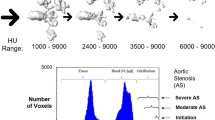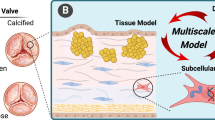Abstract
Calcific aortic valve disease (CAVD) is characterized by calcification accumulation and thickening of the aortic valve cusps, leading to stenosis. The importance of fluid flow shear stress in the initiation and regulation of CAVD progression is well known and has been studied recently using fluid–structure interaction (FSI) models. While cusp calcifications are three-dimensional (3D) masses, previously published FSI models have represented them as either stiffened or thickened two-dimensional (2D) cusps. This study investigates the hemodynamic effect of these calcifications employing FSI models using 3D patient-specific calcification masses. A new reverse calcification technique (RCT) is used for modeling different stages of calcification growth based on the spatial distribution of calcification density. The RCT is applied to generate the 3D calcification deposits reconstructed from a patient-specific CT scans. Our results showed that consideration of 3D calcification deposits led to both higher fluid shear stresses and unique fluid shear stress distribution on the aortic side of the cusps that may have an impact on the calcification growth rate. However, the flow did not seem to affect the geometry of the calcification during the growth phase.







Similar content being viewed by others
References
Alexopoulos A, Bravou V, Peroukides S, Kaklamanis L, Varakis J, Alexopoulos D, Papadaki H (2010) Bone regulatory factors NFATc1 and Osterix in human calcific aortic valves. Int J Cardiol 139:142–149. doi:10.1016/j.ijcard.2008.10.014
Block PC, Palacios IF (1987) Comparison of hemodynamic results of anterograde versus retrograde percutaneous balloon aortic valvuloplasty. Am J Cardiol 60:659–662. doi:10.1016/0002-9149(87)90377-8
Bluestein D, Li YM, Krukenkamp IB (2002) Free emboli formation in the wake of bi-leaflet mechanical heart valves and the effects of implantation techniques. J Biomech 35:1533–1540. doi:10.1016/S0021-9290(02)00093-3
Bonow RO (2006) ACC/AHA 2006 guidelines for the management of patients with valvular heart disease: a report of the American College of Cardiology/American Heart Association Task Force on Practice Guidelines. J Am Coll Cardiol. doi:10.1016/j.jacc.2006.05.021
Butcher JT, Tressel S, Johnson T, Turner D, Sorescu G, Jo H, Nerem RM (2006) Transcriptional profiles of valvular and vascular endothelial cells reveal phenotypic differences: influence of shear stress. Arterioscler Thromb Vasc Biol 26:69–77. doi:10.1161/01.ATV.0000196624.70507.0d
Chandra S, Rajamannan N, Sucosky P (2012) Computational assessment of bicuspid aortic valve wall-shear stress: implications for calcific aortic valve disease. Biomech Model Mechanobiol 11:1085–1096. doi:10.1007/s10237-012-0375-x
Choi K, Kuhn JL, Ciarelli MJ, Goldstein SA (1990) The elastic moduli of human subchondral, trabecular, and cortical bone tissue and the size-dependency of cortical bone modulus. J Biomech 23:1103–1113. doi:10.1016/0021-9290(90)90003-L
De Hart J, Peters GWM, Schreurs PJG, Baaijens FTP (2003) A three-dimensional computational analysis of fluid–structure interaction in the aortic valve. J Biomech 36:103–112. doi:10.1016/S0021-9290(02)00244-0
Haj-Ali R, Marom G, Ben Zekry S, Rosenfeld M, Raanani E (2012) A general three-dimensional parametric geometry of the native aortic valve and root for biomechanical modeling. J Biomech 45:2392–2397. doi:10.1016/j.jbiomech.2012.07.017
Halevi R, Hamdan A, Marom G, Mega M, Raanani E, Haj-Ali R (2015) Progressive aortic valve calcification: three-dimensional visualization and biomechanical analysis. J Biomech 48:489–497. doi:10.1016/j.jbiomech.2014.12.004
Handke M, Heinrichs G, Beyersdorf F, Olschewski M, Bode C, Geibel A (2003) In vivo analysis of aortic valve dynamics by transesophageal 3-dimensional echocardiography with high temporal resolution. J Thorac Cardiovasc Surg 125:1412–1419. doi:10.1016/S0022-5223(02)73604-0
Hounsfield GN (1973) Computerized transverse axial scanning (tomography): part 1. Description of system. Br J Radiol 46:1016–1022. doi:10.1259/0007-1285-46-552-1016
Katayama S, Umetani N, Hisada T, Sugiura S (2013) Bicuspid aortic valves undergo excessive strain during opening: a simulation study. J Thorac Cardiovasc Surg 145:1570–1576. doi:10.1016/j.jtcvs.2012.05.032
Kim HS (2009) Nonlinear multi-scale anisotropic material and structural models for prosthetic and native aortic heart valves. Georgia Institute of Technology, Atlanta
Li JKJ (2004) Dynamics of the vascular system. World Scientific, Singapore
Lindroos M, Kupari M, Heikkilä J, Tilvis R (1993) Prevalence of aortic valve abnormalities in the elderly: an echocardiographic study of a random population sample. J Am Coll Cardiol 21:1220–1225. doi:10.1016/0735-1097(93)90249-z
Maleki H (2010) Structural and fluid structure interaction analysis of stenotic aortic valves: application to percutaneous aortic valve replacement. Department of Mechanical and Industrial Engineering, Concordia University, Montreal, Quebec, Cannada
Marom G (2014) Numerical methods for fluid–structure interaction models of aortic valves. Arch Comput Methods Eng. doi:10.1007/s11831-014-9133-9
Marom G, Haj-Ali R, Raanani E, Schäfers HJ, Rosenfeld M (2012) A fluid–structure interaction model of coaptation in fully compliant aortic valves. Med Biol Eng Comput 50:173–182. doi:10.1007/s11517-011-0849-5
Marom G, Peleg M, Halevi R, Rosenfeld M, Raanani E, Hamdan A, Haj-Ali R (2013) Fluid–structure interaction model of aortic valve with porcine-specific collagen fiber alignment in the cusps. ASME J Biomech Eng 135:101001–101006. doi:10.1115/1.4024824
Nishimura RA, Otto CM, Bonow RO, Carabello BA, Erwin JP, Guyton RA, O’Gara PT, Ruiz CE, Skubas NJ, Sorajja P et al (2014) 2014 AHA/ACC guideline for the management of patients with valvular heart disease: a report of the American College of Cardiology/American Heart Association Task Force on Practice Guidelines. J Am Coll Cardiol 63:e57–e185. doi:10.1016/j.jacc.2014.02.536
Otto CM, Lind BK, Kitzman DW, Gersh BJ, Siscovick DS (1999) Association of aortic-valve sclerosis with cardiovascular mortality and morbidity in the elderly. N Engl J Med 341:142–147. doi:10.1056/NEJM199907153410302
Rajamannan NM, Subramaniam M, Rickard D, Stock SR, Donovan J, Springett M, Orszulak T, Fullerton DA, Tajik AJ, Bonow RO et al (2003) Human aortic valve calcification is associated with an osteoblast phenotype. Circulation 107:2181–2184. doi:10.1161/01.cir.0000070591.21548.69
Rho JY, Hobatho MC, Ashman RB (1995) Relations of mechanical properties to density and CT numbers in human bone. Med Eng Phys 17:347–355. doi:10.1016/1350-4533(95)97314-F
Roberts WC, Ko JM (2004) Weights of individual cusps in operatively-excised stenotic three-cuspid aortic valves. Am J Cardiol 94:681–684. doi:10.1016/j.amjcard.2004.05.045
Rosenhek R, Binder T, Porenta G, Lang I, Christ G, Schemper M, Maurer G, Baumgartner H (2000) Predictors of outcome in severe, asymptomatic aortic stenosis. N Engl J Med 343:611–617. doi:10.1056/NEJM200008313430903
Sirois E, Wang Q, Sun W (2011) Fluid simulation of a transcatheter aortic valve deployment into a patient-specific aortic root. Cardiovasc Eng Technol 2:186–195. doi:10.1007/s13239-011-0037-7
Sommer G, Holzapfel GA (2012) 3D constitutive modeling of the biaxial mechanical response of intact and layer-dissected human carotid arteries. J Mech Behav Biomed Mater 5:116–128. doi:10.1016/j.jmbbm.2011.08.013
Stein PD, Sabbah HN (1976) Turbulent blood flow in the ascending aorta of humans with normal and diseased aortic valves. Circ Res 39:58–65. doi:10.1161/01.res.39.1.58
Sucosky P, Balachandran K, Elhammali A, Jo H, Yoganathan AP (2009) Altered shear stress stimulates upregulation of endothelial VCAM-1 and ICAM-1 in a BMP-4—and TGF-β1—dependent pathway. Arterioscler Thromb Vasc Biol 29:254–260. doi:10.1161/atvbaha.108.176347
Thubrikar MJ (1990) The aortic valve. CRC Press Inc., Boca Raton
Van Loon R (2010) Towards computational modelling of aortic stenosis. Int J Numer Methods Biomed Eng 26:405–420. doi:10.1002/cnm.1270
Wang SH, Lee LP, Lee JS (2001) A linear relation between the compressibility and density of blood. J Acoust Soc Am 109:390–396. doi:10.1121/1.1333419
Weinberg E, Mack P, Schoen F, García-Cardeña G, Kaazempur Mofrad M (2010) Hemodynamic environments from opposing sides of human aortic valve leaflets evoke distinct endothelial phenotypes in vitro. Cardiovasc Eng 10:5–11. doi:10.1007/s10558-009-9089-9
Weinberg EJ, Mofrad MRK (2008) A multiscale computational comparison of the bicuspid and tricuspid aortic valves in relation to calcific aortic stenosis. J Biomech 41:3482–3487. doi:10.1016/j.jbiomech.2008.08.006
Weinberg EJ, Schoen FJ, Mofrad MRK (2009) A computational model of aging and calcification in the aortic heart valve. PLoS ONE 4:e5960. doi:10.1371/journal.pone.0005960
Weston MW, LaBorde DV, Yoganathan AP (1999) Estimation of the shear stress on the surface of an aortic valve leaflet. Ann Biomed Eng 27:572–579. doi:10.1114/1.199
Yap CH, Saikrishnan N, Tamilselvan T, Yoganathan AP (2012) Experimental measurement of dynamic fluid shear stress on the aortic surface of the aortic valve leaflet. Biomech Model Mechanobiol 11:171–182. doi:10.1007/s10237-011-0301-7
Yap CH, Saikrishnan N, Yoganathan AP (2012) Experimental measurement of dynamic fluid shear stress on the ventricular surface of the aortic valve leaflet. Biomech Model Mechanobiol 11:231–244. doi:10.1007/s10237-011-0306-2
Yin W, Alemu Y, Affeld K, Jesty J, Bluestein D (2004) Flow-induced platelet activation in bileaflet and monoleaflet mechanical heart valves. Ann Biomed Eng 32:1058–1066. doi:10.1114/B:ABME.0000036642.21895.3f
Yoganathan A, Chandran KB, Sotiropoulos F (2005) Flow in prosthetic heart valves: state-of-the-art and future directions. Ann Biomed Eng 33:1689–1694. doi:10.1007/s10439-005-8759-z
Yoganathan AP (1988) Fluid mechanics of aortic stenosis. Eur Heart J Suppl 9:13–17. doi:10.1093/eurheartj/9.suppl_E.13
Acknowledgments
This work was partially supported by grants from the Nicholas and Elizabeth Slezak Super Center for Cardiac Research and Biomedical Engineering at Tel Aviv University, Seymour Pyper Research Fund at Sheba Medical Center, and National Institutes of Health: NIBIB Quantum Award: Implementation Phase II U01 EB012487-0.
Author information
Authors and Affiliations
Corresponding author
Ethics declarations
Conflict of interest
All authors state that they have no financial and/or personal relationships with other people or organizations that could inappropriately influence or bias the publication of this study.
Rights and permissions
About this article
Cite this article
Halevi, R., Hamdan, A., Marom, G. et al. Fluid–structure interaction modeling of calcific aortic valve disease using patient-specific three-dimensional calcification scans. Med Biol Eng Comput 54, 1683–1694 (2016). https://doi.org/10.1007/s11517-016-1458-0
Received:
Accepted:
Published:
Issue Date:
DOI: https://doi.org/10.1007/s11517-016-1458-0




